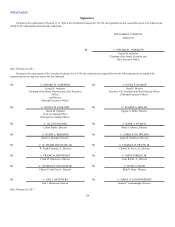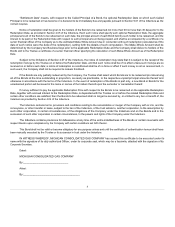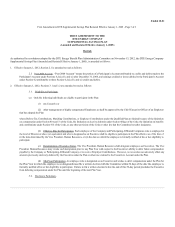DTE Energy 2012 Annual Report Download - page 133
Download and view the complete annual report
Please find page 133 of the 2012 DTE Energy annual report below. You can navigate through the pages in the report by either clicking on the pages listed below, or by using the keyword search tool below to find specific information within the annual report.
the consideration for the issue thereof, and being likewise waived and released pursuant to the Indenture and the Senior Indenture.
This Bond shall be subject to redemption at the option of the Company, in whole at any time or in part from time to time (any such
date of optional redemption, a “Redemption Date”), at an optional redemption price (any such price, a “Redemption Price”) equal to 100% of
the principal amount of the Bonds to be redeemed on the Redemption Date together with the Make-Whole Amount (as defined below), if any,
plus, in each case, accrued and unpaid interest thereon to the Redemption Date.
Notwithstanding the foregoing, installments of interest on the Bonds that are due and payable on Interest Payment Dates falling on
or prior to a Redemption Date will be payable on the Interest Payment Date to the registered Holders as of the close of business on the
relevant Record Date.
“Make-Whole Amount” means, with respect to any Bond, an amount equal to the excess, if any, of the Discounted Value of the
Remaining Scheduled Payments with respect to the Called Principal of such Bond over the amount of such Called Principal, provided that
the Make-Whole Amount may in no event be less than zero. For the purposes of determining the Make-Whole Amount, the following terms
have the following meanings:
“Called Principal” means, with respect to a Bond, the principal of the Bond that is to be redeemed on an optional Redemption Date or
has become or is declared to be immediately due and payable pursuant to Section 9.01 of the Indenture, as the context requires.
“Discounted Value” means, with respect to the Called Principal of a Bond, the amount obtained by discounting all Remaining
Scheduled Payments with respect to such Called Principal from their respective scheduled due dates to the Settlement Date with respect to
such Called Principal, in accordance with accepted financial practice and at a discount factor (applied on the same periodic basis as that on
which interest on the Bond is payable) equal to the Reinvestment Yield with respect to such Called Principal.
“Reinvestment Yield” means, with respect to the Called Principal of a Bond, 50 basis points plus the yield to maturity implied by (i)
the yields reported, as of 10:00 a.m. (New York City time) on the second Business Day preceding the Settlement Date with respect to such
Called Principal, on the display designated as “PX-1” (or such other display as may replace Page PX-1), on Bloomberg Financial Markets for
the most recently issued, actively traded on-the-run, benchmark U.S. Treasury securities having a maturity equal to the Remaining Average
Life of such Called Principal as of such Settlement Date, or (ii) if such yields are not reported as of such time or the yields reported as of such
time are not ascertainable (including by way of interpolation), the Treasury Constant Maturity Series Yields reported, for the latest day for
which such yields have been so reported as of the second Business Day preceding the Settlement Date with respect to such Called Principal,
in Federal Reserve Statistical Release H.15 (519) (or any comparable successor publication) for actively traded U.S. Treasury securities
having a constant maturity equal to the Remaining Average Life of such Called Principal as of such Settlement Date. Such implied yield will
be determined, if necessary, by (a) converting U.S. Treasury bill quotations to bond-equivalent yields in accordance with accepted financial
practice and (b) interpolating linearly on a straight line basis between (1) the most recently issued, actively traded on-the-run, benchmark U.S.
Treasury security with the maturity closest to and greater than the Remaining Average Life and (2) the most recently issued, actively traded
on-the-run, benchmark U.S. Treasury security with the maturity closest to and less than the Remaining Average Life. The Reinvestment
Yield shall be rounded to the number of decimal places as appears in the interest rate of the applicable Bond.
“Remaining Average Life” means, with respect to any Called Principal, the number of years (calculated to the nearest one-twelfth
year) obtained by dividing (i) such Called Principal into (ii) the sum of the products obtained by multiplying (a) the principal component of each
Remaining Scheduled Payment with respect to such Called Principal by (b) the number of years (calculated to the nearest one-twelfth year)
that will elapse between the Settlement Date with respect to such Called Principal and the Stated Maturity of such Remaining Scheduled
Payment.
“Remaining Scheduled Payments” means, with respect to the Called Principal of a Bond, all payments of such Called Principal and
interest thereon that would be due after the Settlement Date with respect to such Called Principal if no payment of such Called Principal were
made prior to its Stated Maturity, provided that if such Settlement Date is not a date on which interest payments are due to be made under the
terms of the Senior Note, then the amount of the next succeeding scheduled interest payment will be reduced by the amount of interest
accrued to such Settlement Date and required to be paid on such Settlement Date.
7
























